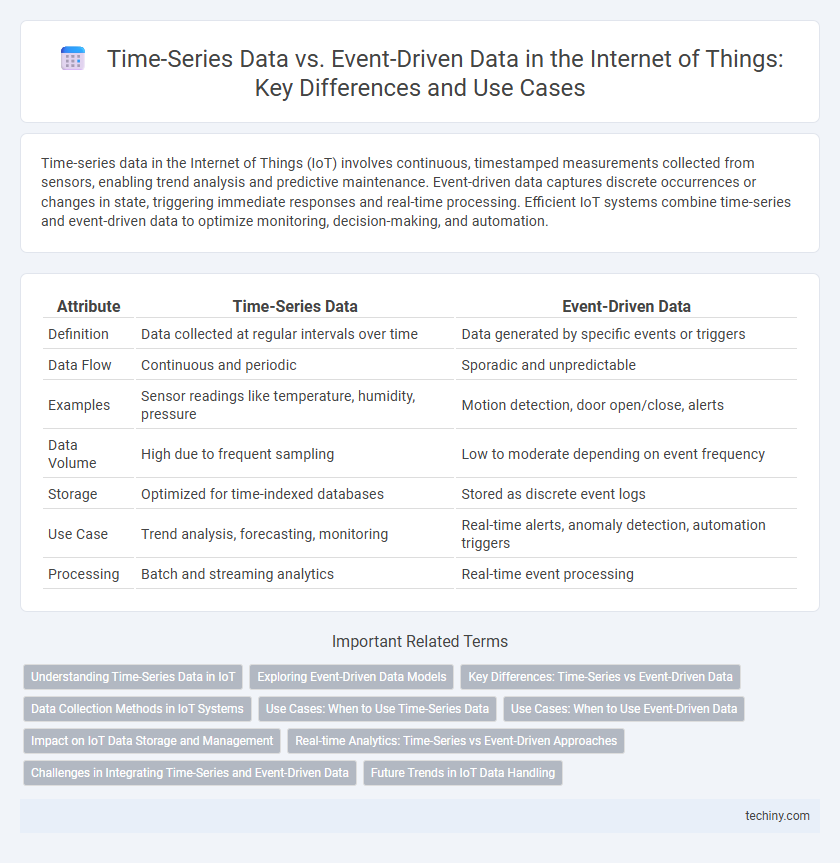Time-series data in the Internet of Things (IoT) involves continuous, timestamped measurements collected from sensors, enabling trend analysis and predictive maintenance. Event-driven data captures discrete occurrences or changes in state, triggering immediate responses and real-time processing. Efficient IoT systems combine time-series and event-driven data to optimize monitoring, decision-making, and automation.
Table of Comparison
| Attribute | Time-Series Data | Event-Driven Data |
|---|---|---|
| Definition | Data collected at regular intervals over time | Data generated by specific events or triggers |
| Data Flow | Continuous and periodic | Sporadic and unpredictable |
| Examples | Sensor readings like temperature, humidity, pressure | Motion detection, door open/close, alerts |
| Data Volume | High due to frequent sampling | Low to moderate depending on event frequency |
| Storage | Optimized for time-indexed databases | Stored as discrete event logs |
| Use Case | Trend analysis, forecasting, monitoring | Real-time alerts, anomaly detection, automation triggers |
| Processing | Batch and streaming analytics | Real-time event processing |
Understanding Time-Series Data in IoT
Time-series data in IoT consists of sequential measurements collected at consistent intervals, enabling continuous monitoring of sensor outputs such as temperature, humidity, and energy consumption. This type of data provides crucial insights for predictive analytics, trend detection, and anomaly identification in smart devices and industrial systems. Effective handling of time-series data relies on optimized storage, scalable processing frameworks, and advanced algorithms tailored for temporal patterns.
Exploring Event-Driven Data Models
Event-driven data models in the Internet of Things (IoT) prioritize real-time processing of discrete occurrences, capturing changes as events rather than continuous streams. This approach enables efficient handling of sporadic sensor triggers, alarms, or state changes, optimizing resource usage and response times. Unlike time-series data, which focuses on sequential time-stamped readings, event-driven models emphasize context and causality for immediate decision-making and automation.
Key Differences: Time-Series vs Event-Driven Data
Time-series data in the Internet of Things (IoT) consists of continuous, timestamped measurements collected at regular intervals, enabling trend analysis and predictive maintenance. Event-driven data, by contrast, captures asynchronous occurrences triggered by specific conditions or changes, facilitating real-time responses and anomaly detection. The key differences lie in data frequency, structure, and use cases: time-series supports historical analysis with evenly spaced data points, while event-driven caters to dynamic, irregular events requiring immediate action.
Data Collection Methods in IoT Systems
Time-series data in IoT systems involves continuous, timestamped measurements from sensors, enabling trend analysis and predictive maintenance by capturing readings at regular intervals. Event-driven data collection captures discrete occurrences triggered by specific conditions or actions, such as alarms or sensor threshold breaches, optimizing bandwidth and processing by transmitting data only when significant events occur. Combining both methods enhances IoT system efficiency by balancing comprehensive monitoring with responsive alerts, tailored to diverse application needs in smart environments.
Use Cases: When to Use Time-Series Data
Time-series data is ideal for monitoring and analyzing continuous sensor outputs in IoT applications such as predictive maintenance, environmental tracking, and energy management. It enables real-time trend analysis, anomaly detection, and forecasting by capturing data points at consistent intervals. Industries like manufacturing, smart cities, and agriculture rely on time-series data to optimize operations and make data-driven decisions.
Use Cases: When to Use Event-Driven Data
Event-driven data is essential in Internet of Things applications that require immediate response to specific triggers, such as anomaly detection in industrial machines or security breach alerts in smart home systems. This data model excels in scenarios where actions must be initiated promptly based on discrete events, enabling real-time decision-making and automation. Use event-driven data when monitoring critical thresholds or detecting incidents that demand instantaneous intervention to prevent failures or ensure safety.
Impact on IoT Data Storage and Management
Time-series data in IoT generates continuous, timestamped sensor readings that demand scalable storage solutions optimized for rapid write and query performance, enabling efficient trend analysis and anomaly detection. Event-driven data captures irregular, discrete occurrences requiring flexible storage architectures to handle sporadic data bursts and support real-time processing for immediate response and alerting. Balancing time-series and event-driven data influences IoT data management strategies, affecting database selection, indexing methods, and resource allocation to ensure optimal storage efficiency and timely data accessibility.
Real-time Analytics: Time-Series vs Event-Driven Approaches
Time-series data in IoT captures continuous sensor readings over intervals, enabling trend analysis and predictive maintenance through real-time analytics. Event-driven data focuses on discrete occurrences like anomalies or status changes, triggering immediate responses and action-based workflows for critical operations. Combining time-series monitoring with event-driven detection enhances operational efficiency and decision-making accuracy in real-time IoT environments.
Challenges in Integrating Time-Series and Event-Driven Data
Integrating time-series data and event-driven data in the Internet of Things (IoT) environment presents significant challenges due to differing data structures and temporal resolutions. Time-series data consists of continuous, sequential measurements, while event-driven data captures discrete, asynchronous occurrences, complicating synchronization and correlation efforts. Ensuring data consistency, managing storage scalability, and enabling real-time analytics require advanced processing frameworks capable of handling heterogeneous data streams effectively.
Future Trends in IoT Data Handling
Time-series data and event-driven data are shaping the future of IoT data handling by enabling real-time analytics and predictive maintenance for smart devices. Advanced machine learning algorithms and edge computing will leverage continuous sensor readings from time-series data alongside sporadic, context-rich event-driven triggers to optimize network efficiency and decision-making. The integration of these data types will drive enhanced automation, adaptive resource management, and scalable IoT ecosystems.
Time-series data vs Event-driven data Infographic

 techiny.com
techiny.com